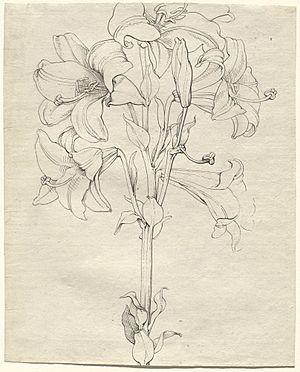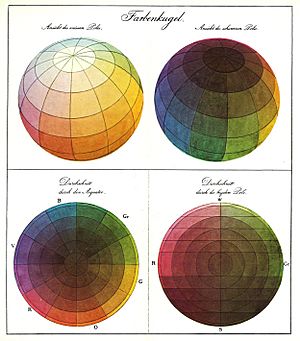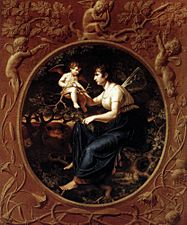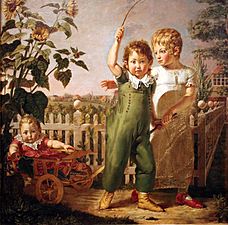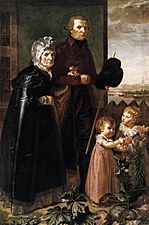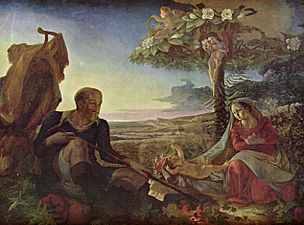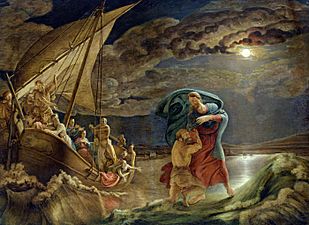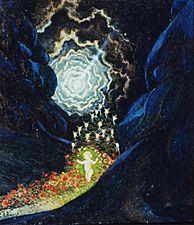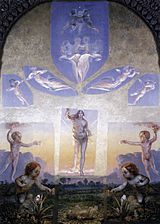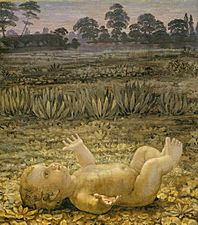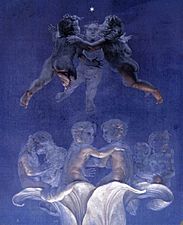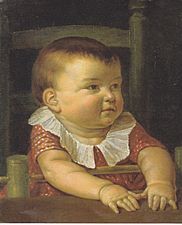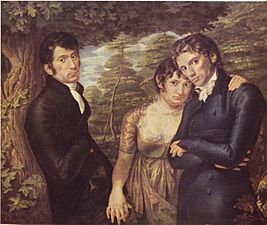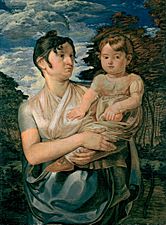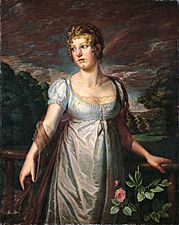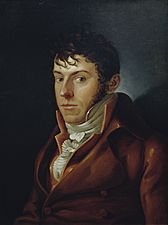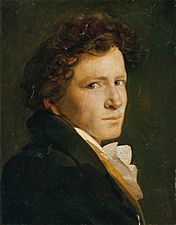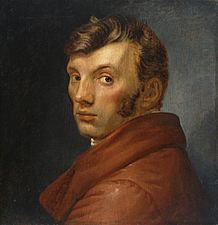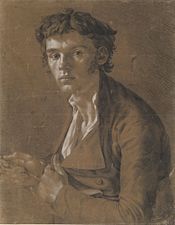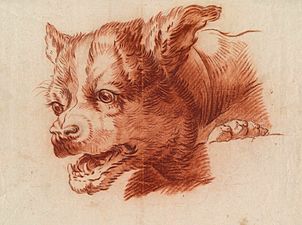Philipp Otto Runge facts for kids
Quick facts for kids
Philipp Otto Runge
|
|
|---|---|
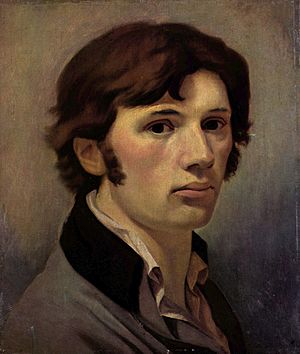
Self-portrait, ca. 1802, Hamburger Kunsthalle
|
|
| Born | 23 July 1777 Wolgast, Germany
|
| Died | 2 December 1810 (aged 33) Hamburg, Germany
|
| Resting place | Ohlsdorf Cemetery, Hamburg, Germany (moved from the Church of Saint Peter, Hamburg cemetery in 1935) |
| Known for | Artist: painter and draftsman |
|
Notable work
|
The Hülsenbeck Children, Tageszeiten (Times of Day), The Morning |
| Movement | Romanticism |
Philipp Otto Runge (German: [ˈʁʊŋə]; 1777–1810) was an important German artist. He was a talented draftsman, painter, and also studied color. Runge and Caspar David Friedrich are seen as the main painters of the German Romantic art movement. This movement focused on emotion, nature, and individual experiences.
Art historians often compare Runge to the English artist William Blake. Runge had a very bright mind and knew a lot about the books and ideas of his time. He wrote many letters and was friends with famous people like Johann Wolfgang von Goethe. Runge's paintings often used lots of symbols and hidden meanings.
For eight years, he worked on his biggest project, Tageszeiten (Times of Day). This was meant to be four huge paintings, each about 50 square meters. These paintings were part of an even bigger idea called a Gesamtkunstwerk. This means a "total work of art" that would combine poetry, music, and architecture. Sadly, he died before he could finish it. Runge wanted to create new ways to show spiritual ideas through symbols in nature, moving away from traditional Christian art. He also wrote an important book about color theory called Sphere of Colors, which was published in 1810, the year he passed away.
Contents
Early Life and Artistic Journey
Runge was born in 1777 in Wolgast, a town in northeast Germany. It was part of Swedish Pomerania at that time. He was often sick with tuberculosis from a young age and had poor health his whole life. As a child, he learned to make scissor-cut silhouettes from his mother, a skill he used throughout his life.
His father was a successful merchant and ship owner. Philipp and his older brother Daniel were expected to join the family business. Philipp moved to Hamburg around 1793 to work as an apprentice for his brother. In Hamburg, he met writers, publishers, and art collectors. They encouraged his interest in art, philosophy, and learning.
Runge started taking drawing lessons in Hamburg in 1797. It was only in his early twenties that he decided to become a professional artist.
Art Studies and Influences
From 1798 to 1801, Runge studied painting at the Copenhagen Academy (now the Royal Danish Academy of Fine Arts). He then went to the Dresden Academy of Fine Arts from 1801 to 1804. There, he met more people involved in the Romantic movement. The writer Ludwig Tieck was very important. He introduced Runge to new books and the mystical ideas of Jakob Böhme and Novalis.
In 1801, Runge met Pauline Bassenge in Dresden. They got married on April 3, 1804, and soon moved back to Hamburg. They had four children. Runge died in 1810 from tuberculosis when he was only 33 years old. His art career lasted just over ten years. Much of his artwork was later given to the Hamburger Kunsthalle by his wife, Pauline, in 1872.
In 1803, Runge met Johann Wolfgang von Goethe in Weimar. They became friends because they both loved color and art.
Runge's Art and Ideas
Runge was a deeply religious and mystical person. In his art, he tried to show the harmony of the universe. He used symbols of color, shapes, and numbers to do this. For example, he believed blue, yellow, and red represented the Christian trinity. He connected blue with God and night, red with morning, evening, and Jesus, and yellow with the Holy Spirit.
Runge was interested in the idea of a "total work of art" (Gesamtkunstwerk). This meant combining all art forms. He planned his Times of the Day paintings to be seen in a special building. They would be viewed with music and his own poetry playing. In 1803, he made large prints of his Times of the Day drawings. These prints became very popular, and he even gave a set to Goethe. He painted two versions of "Morning," but the other paintings in the series were never finished beyond drawings. "Morning" started a new kind of landscape art that showed religion and deep feelings.
Runge was also one of the best German portrait painters of his time. Many of his portraits are in Hamburg. His style was very clear, sharp, and intense. Sometimes it even looked a little bit simple or "naïve."
Runge and Color Theory
Runge's interest in color came naturally from his work as a painter and his curious mind. He believed that there are only three main colors: yellow, red, and blue. His goal was to show all the colors that could be made by mixing these three, along with white and black.
Around 1807, he came up with the idea of the "color sphere." He imagined the colors arranged in a sphere, with white at one pole and black at the opposite pole. He hoped his experiments with mixing colors would prove that the sphere shape was correct. With encouragement from Goethe, he wrote a book about his color sphere in 1808. It was published in 1810. The book explained the color sphere and included essays on color harmony and color in nature.
Runge's early death meant his work on color theory didn't have as much impact as it could have. However, Goethe mentioned it in his own book on color, Farbenlehre, calling it a successful effort.
Legacy and Influence
Runge's art has been shown in many important exhibitions. These include "German Masters of the Nineteenth Century" at the Metropolitan Museum of Art and "Runge’s Cosmos" at the Kunsthalle Hamburg. The art critic Robert Hughes said Runge was "the closest equivalent to William Blake that Germany produced."
Runge's painting, The Morning, from 1808, is considered his greatest work. It was meant to be part of his Times of Day series of religious paintings. The four paintings were planned for a Gothic chapel, with music and poetry. Runge hoped this series would inspire a new kind of spiritual art. The series, except for "Morning" and "Day," was never fully painted. However, four prints of his drawings were displayed in Johann Wolfgang von Goethe's music room. Runge's unique way of showing flowers like amaryllises and lilies in Times of Day is seen as an early example of ideas that would appear in the Art Nouveau movement almost 100 years later.
Gallery
All works are oil paintings in the collection of the Hamburger Kunsthalle unless noted otherwise.
Tageszeiten (Times of Day)
Portraits
Drawings
See also
 In Spanish: Philipp Otto Runge para niños
In Spanish: Philipp Otto Runge para niños


